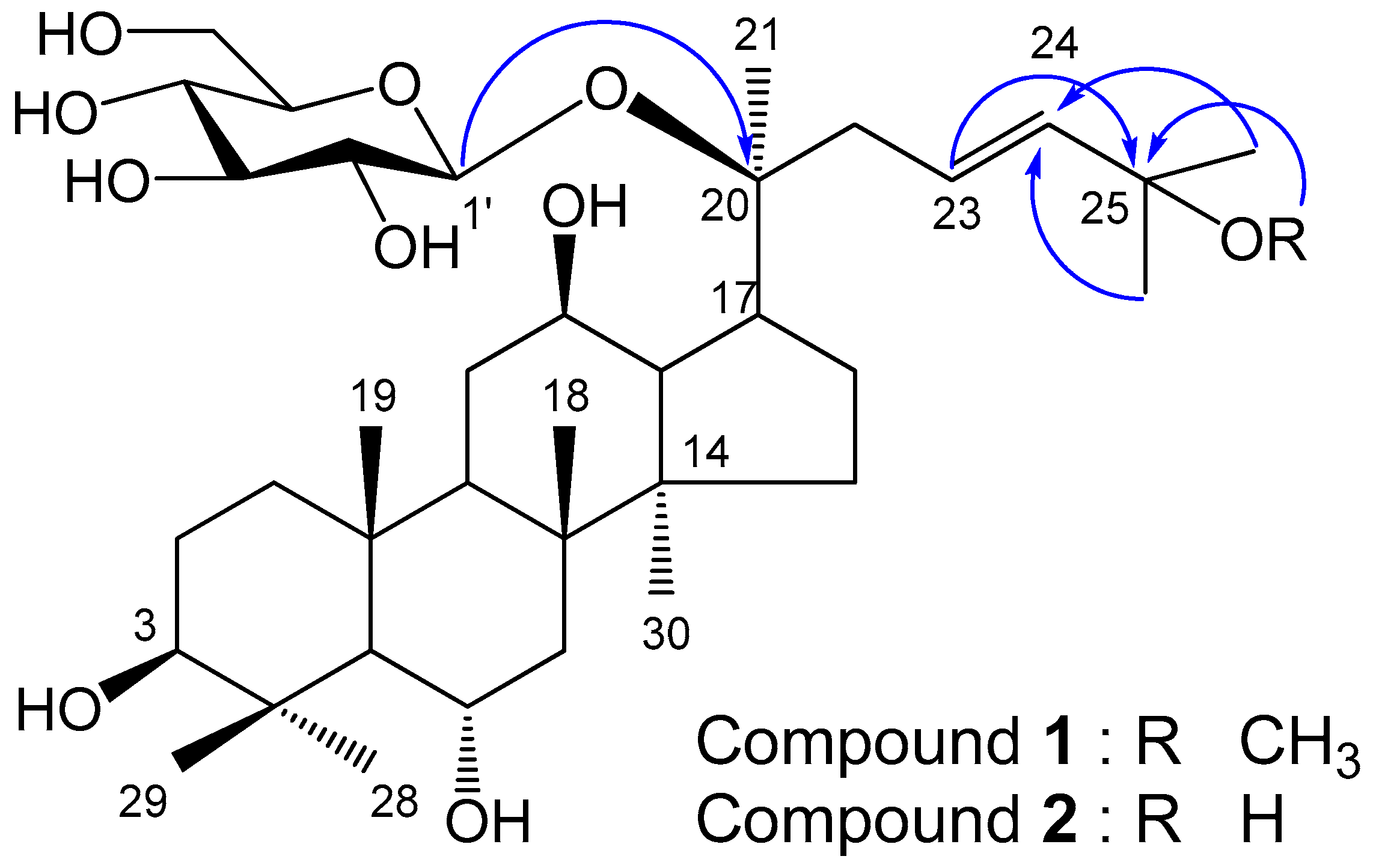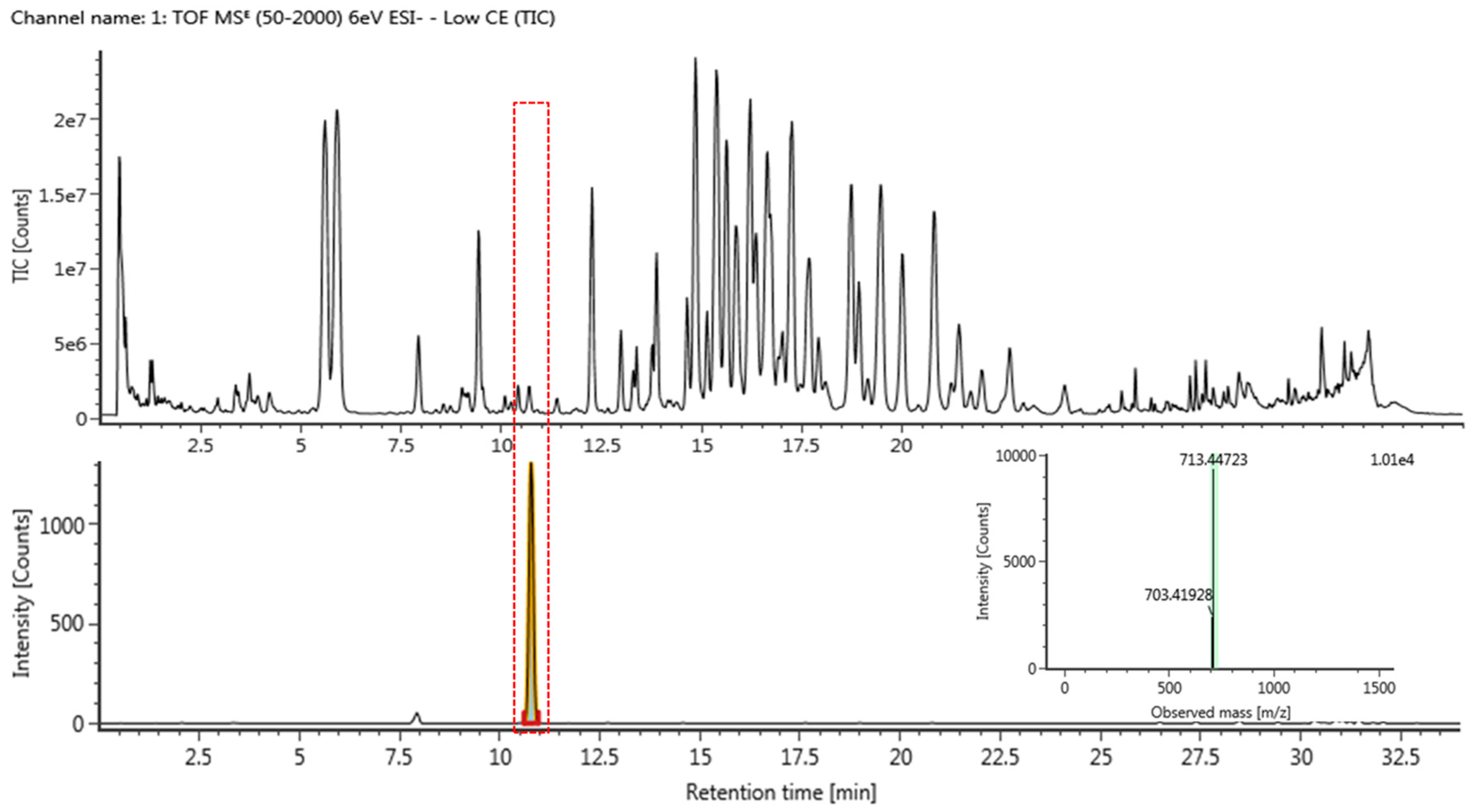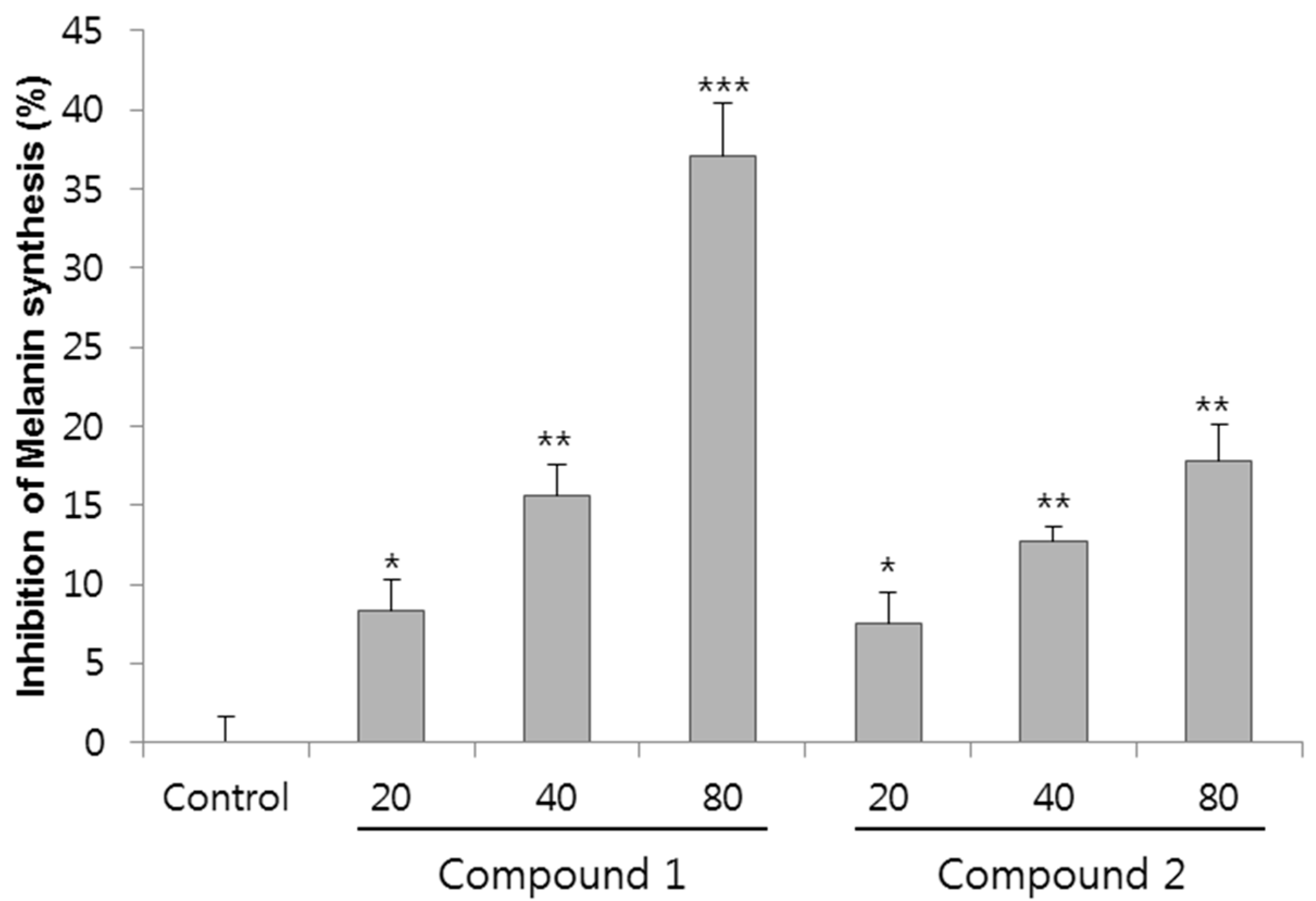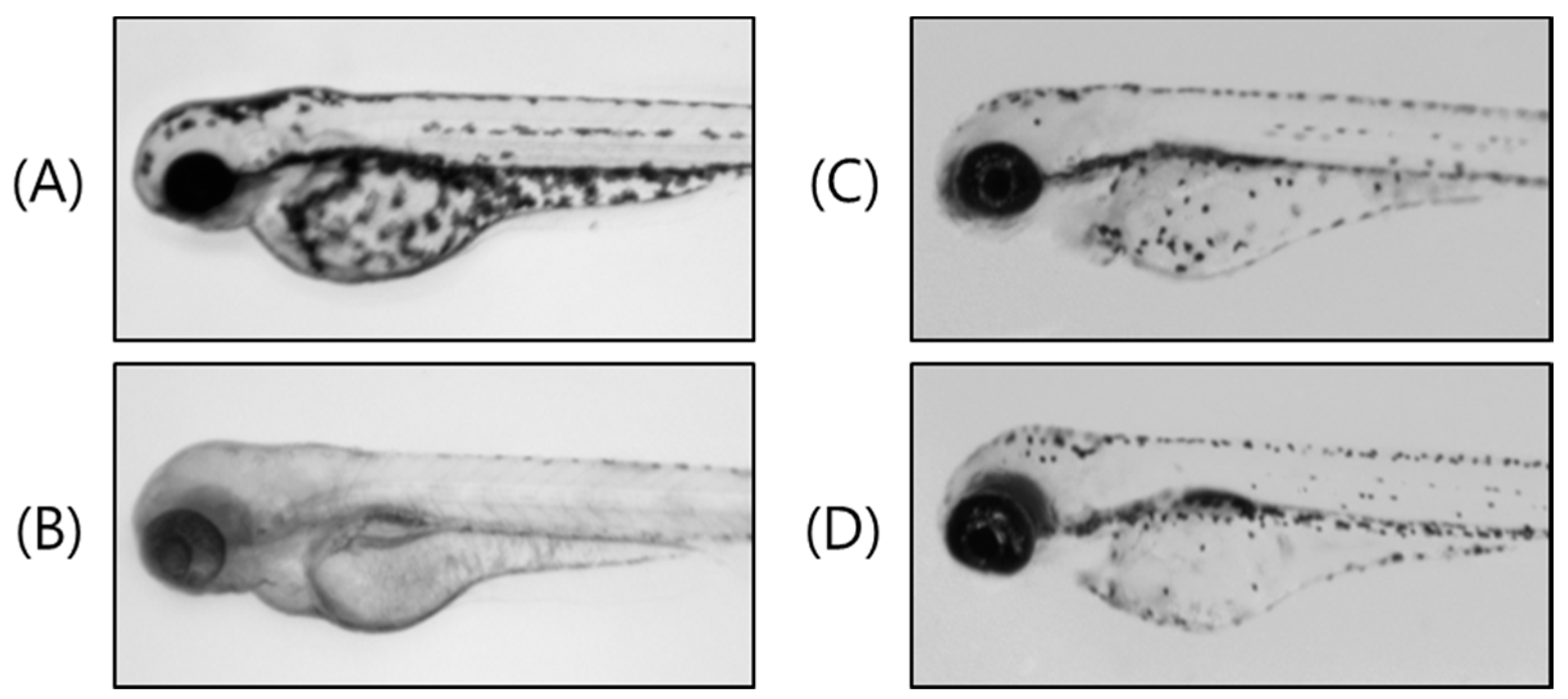Isolation and Quantification of Ginsenoside Rh23, a New Anti-Melanogenic Compound from the Leaves of Panax ginseng
Abstract
:1. Introduction
2. Results and Discussion
3. Experimental
3.1. General
3.2. Plant Materials
3.3. Extraction and Isolation
3.4. Spectroscopic Data
3.5. Quantitative Analysis of Novel Compound 1 Using UPLC-QTOF/MS
3.6. Cell Culture
3.7. Melanin Assay
3.8. Origin and Maintenance of Parental Fish
3.9. Compounds Treatment and Phenotype-Based Evaluation
4. Conclusions
Supplementary Materials
Acknowledgments
Author Contributions
Conflicts of Interest
References
- Ben, E.W.; Michael, W. Medicinal plants of the world. In Shinilbooks; Timber Press Inc.: Portland, OR, USA, 2007. [Google Scholar]
- Park, J.D.; Rhee, D.K.; Lee, Y.H. Biological activities and chemistry of saponins from Panax ginseng C.A. Meyer. Phytochemistry 2005, 4, 159–175. [Google Scholar] [CrossRef]
- Kwon, S.J.; Chung, D.K. The immune-enhancing effect of mountain gown ginseng, mountain cultivated ginseng, and Panax ginseng. J. Orient. Neuropsychiatry 2004, 15, 89–101. [Google Scholar]
- Gillis, C.N. Panax ginseng pharmacology: A nitric oxide link? Biochem. Pharmacol. 1997, 54, 1–8. [Google Scholar] [CrossRef]
- Kang, K.S.; Yamabe, N.; Kim, H.Y.; Yokozawa, T. Effect of sun ginseng methanol extract on lipopolysaccharide-induced liver injury in rats. Phytomedicine 2007, 14, 840–845. [Google Scholar] [CrossRef] [PubMed]
- Jiang, S.; Ren, D.; Li, J.; Yuan, G.; Li, H.; Xu, G.; Han, X.; Du, P.; An, L. Effects of compound K on hyperglycemia and insulin resistance in rats with type 2 diabetes mellitus. Fioterapia 2014, 95, 58–64. [Google Scholar] [CrossRef] [PubMed]
- Kim, H.S.; Lee, E.H.; Ko, S.R.; Choi, K.J.; Park, J.H.; Im, D.S. Effects of ginsenoside Rg3 and Rh2 on the proliferation of prostate cancer cells. Arch. Pharm. Res. 2004, 27, 429–435. [Google Scholar] [CrossRef] [PubMed]
- Nocerino, E.; Amato, M.; Izzo, A.A. The aphrodisiac and adaptogenic properties of ginseng. Fitoterapia 2000, 71, S1–S5. [Google Scholar] [CrossRef]
- Keum, Y.S.; Park, K.K.; Lee, J.M.; Chun, K.S.; Park, J.H.; Lee, S.K.; Kwon, H.J.; Surh, Y.J. Antioxidant and anti-tumor promoting activities of the methanol extract of heat-processed ginseng. Cancer Lett. 2000, 150, 41–48. [Google Scholar] [CrossRef]
- Kim, G.S.; Lee, S.E.; Noh, H.J.; Kwon, H.; Lee, S.W.; Kim, S.Y.; Kim, Y.B. Effects of natural bioactive products on the growth and ginsenoside contents of Panax ginseng cultured in an aeroponic system. J. Ginseng Res. 2012, 36, 430–441. [Google Scholar] [CrossRef] [PubMed]
- Choi, S.Y.; Cho, C.W.; Lee, Y.M.; Kim, S.S.; Lee, S.H.; Kim, K.T. Comparison of ginsenoside and phenolic ingredient contents in hydroponically-cultivated ginseng leaves, fruits, and roots. J. Ginseng Res. 2012, 36, 425–429. [Google Scholar] [CrossRef] [PubMed]
- Matsuda, H.; Nakamura, S.; Kubo, M. Studies of cuticle drugs from natural sources. II. Inhibitory effects of Prunus plants on melanin biosynthesis. Biol. Pharm. Bull. 1994, 17, 1417–1420. [Google Scholar] [CrossRef] [PubMed]
- Duncan, C.L.; Foster, E.M. Effect of sodium nitrite, sodium chloride, and sodium nitrate on germination and outgrowth of anaerobic spores. Appl. Microbiol. 1968, 16, 406–411. [Google Scholar] [PubMed]
- Shimizu, K.; Yasutake, S.; Kondo, R. A new stilbene with tyrosinase inhibitory activity from Chlorophora excels. Chem. Pharm. Bull. 2003, 51, 318–319. [Google Scholar] [CrossRef] [PubMed]
- Park, S.H.; Kim, D.S.; Kim, W.G.; Ryoo, I.J.; Lee, D.H.; Huh, C.H.; Youn, S.W.; Yoo, I.D.; Park, K.C. Terrin: A new melanogenesis inhibitor and its mechanism. Cell. Mol. Life 2004, 61, 2878–2885. [Google Scholar] [CrossRef] [PubMed]
- Kong, Y.H.; Jo, Y.O.; Cho, C.W.; Son, D.W.; Park, S.J.; Rho, J.H.; Choi, S.Y. Inhibitory effects of cinnamic acid on melanin biosynthesis in skin. Biol. Pharm. Bull. 2008, 31, 946–948. [Google Scholar] [CrossRef] [PubMed]
- Hwang, E.Y.; Choi, S.Y. Quantitative analysis of phenolic compounds in different parts of Panax ginseng C.A. Meyer and its inhibitory effect on melanin biosynthesis. Korean J. Med. Crop Sci. 2006, 14, 148–152. [Google Scholar]
- Im, S.J.; Kim, K.N.; Yun, Y.G.; Lee, J.C.; Mun, Y.J.; Kim, J.H.; Woo, W.H. Effect of radix ginseng and radix trichosanthis on the melanogenesis. Biol. Pharm. Bull. 2003, 26, 849–853. [Google Scholar] [CrossRef] [PubMed]
- Hwang, E.Y.; Kong, Y.H.; Lee, Y.C.; Kim, Y.C.; Yoo, K.M.; Jo, Y.O. Comparison of phenolic compounds contents between white and red ginseng and their inhibitory effect on melanin biosynthesis. J. Ginseng Res. 2006, 30, 82–87. [Google Scholar]
- Zhang, Y.C.; Pi, Z.F.; Liu, C.M.; Song, F.R.; Liu, Z.Q.; Liu, S.Y. Analysis of low-polar ginsenosides in steamed Panax ginseng at high-temperature by HPLC-ESI-MS/MS. Chem. Res. Chin. Univ. 2012, 28, 31–36. [Google Scholar]
- Xie, Y.Y.; Luo, D.; Cheng, Y.J.; Ma, J.F.; Wang, Y.M.; Liang, Q.L.; Luo, G.A. Steaming-induced chemical transformations and holistic quality assessment of red ginseng derived from Panax ginseng by means of HPLC-ESI-MS/MSn based multicomponent quantification fingerprint. J. Agric. Food Chem. 2012, 60, 8213–8224. [Google Scholar] [CrossRef] [PubMed]
- Liu, G.Y.; Li, X.W.; Wang, N.B.; Zhou, H.Y.; Wei, W.; Gui, M.Y.; Yang, B.; Jin, Y.R. Three new dammarane-type triterpene saponins from the leaves of Panax ginseng C.A. Meyer. J. Asian Nat. Prod. Res. 2010, 12, 865–873. [Google Scholar] [CrossRef] [PubMed]
- Xing, Q.; Liang, T.; Shen, G.; Wang, X.; Jin, Y.; Liang, X. Comprehensive HILIC x RPLC with mass spectrometry detection for the analysis of saponins in Panax notoginseng. Analyst 2012, 137, 2239–2249. [Google Scholar] [CrossRef] [PubMed]
- Love, D.R.; Pichler, F.B.; Dodd, A.; Copp, B.R.; Greenwood, D.R. Technology for high-throughput screen: The present and future using zebrafish. Curr. Opin. Biotechnol. 2004, 15, 564–571. [Google Scholar] [CrossRef] [PubMed]
- Uwe, S.; Stefan, S.; Pobert, G.; Petra, G.; Henner, H.; Sepand, R.; Axel, S.; Ingrid, S.; Carsten, W.; Hilda, W.; et al. Zebrafish embryos as an alternative to animal experiments-A commentary on the definition of the onset of protected life stage in animal welfare regulations. Reprod. Toxicol. 2012, 33, 128–132. [Google Scholar]
- Chio, T.Y.; Kim, J.H.; Ko, D.H.; Kim, C.H.; Hwang, J.S.; Ahn, S.; Kim, S.Y.; Kim, C.D.; Lee, J.H.; Yoo, T.J. Zebrafish ax a new model for phenotype-based screening of melanogenic regulatory compounds. Pigment Cell Res. 2007, 20, 120–127. [Google Scholar] [CrossRef] [PubMed]
- Elsalini, O.A.; Rohr, K.B. Phenylthiourea disrupts thyroid function in developing zebrafish. Dev. Genes Evol. 2003, 212, 593–598. [Google Scholar] [PubMed]
- Lee, D.Y.; Cha, B.J.; Lee, Y.S.; Kim, G.S.; Noh, H.J.; Kim, S.Y.; Kang, H.C.; Kim, J.H.; Baek, N.I. The potential of minor ginsenosides isolated from the leaves of Panax ginseng as inhibitors of melanogenesis. Int. J. Mol. Sci. 2015, 16, 1677–1690. [Google Scholar] [CrossRef] [PubMed]
- Li, J.; Huang, M.; Teoh, H.; Man, R.Y. Panax quinquefolium saponins protects low density lipoproteins from oxidation. Life Sci. 1999, 64, 53–62. [Google Scholar] [CrossRef]
- Li, T.S.C.; Mazza, G.; Cottrell, A.C.; Gao, L. Ginsenosides in roots and leaves of American ginseng. J. Agric. Food Chem. 1996, 44, 717–720. [Google Scholar] [CrossRef]
- Jung, C.H.; Seog, H.M.; Choi, I.W.; Park, M.W.; Cho, H.Y. Antioxidant properties of various solvent extracts from wild ginseng leaves. LWT 2006, 39, 266–274. [Google Scholar] [CrossRef]
- National Institute of Crop Science. Ginseng GAP Standard Cultivation Guideline; National Institute of Crop Science, Rural Development Administration: Suwon, Korea, 2009. [Google Scholar]
- Karlsson, J.; Von Hofsten, J.; Olsson, P.E. Genearting transparent zebrafish: A refined method to improve detection of gene expression during embryonic development. Mar. Biotechnol. 2001, 3, 522–527. [Google Scholar] [CrossRef] [PubMed]
Sample Availability: Samples of the compounds 1 and 2 are available from the authors. |




| Compound 1 | Compound 2 | |||
|---|---|---|---|---|
| No. | δH in ppm, J in Hz | δC | δH in ppm, J in Hz | δC |
| 1 | 1.73, 1.02 | 39.4 | 1.70, 1.00 | 39.5 |
| 2 | 1.84, 1.83 | 28.1 | 1.83, 1.81 | 28.1 |
| 3 | 3.49 (1H, dd, J = 11.6, 4.8 Hz) | 78.5 | 3.50 (1H, dd, J = 11.2, 5.2 Hz) | 78.5 |
| 4 | - | 40.3 | - | 40.3 |
| 5 | 1.21 (1H, d, J = 10.4 Hz) | 61.8 | 1.20 (1H, d, J = 10.4 Hz) | 61.8 |
| 6 | 4.38 (1H, m) | 67.7 | 4.37 (1H, m) | 67.7 |
| 7 | 1.92, 1.87 | 47.4 | 1.91, 1.86 | 47.4 |
| 8 | - | 41.2 | - | 41.2 |
| 9 | 1.54 | 49.3 | 1.53 | 49.8 |
| 10 | - | 39.4 | - | 39.3 |
| 11 | 2.11, 1.58 | 31.0 | 2.08, 1.53 | 31.0 |
| 12 | 4.03 (1H, m) | 70.3 | 4.03 (1H, m) | 70.4 |
| 13 | 1.97 (1H, m) | 49.3 | 1.97 (1H, m) | 49.2 |
| 14 | - | 51.4 | - | 51.4 |
| 15 | 1.61, 0.99 | 30.7 | 1.57, 0.99 | 30.6 |
| 16 | 1.74, 1.40 | 26.4 | 1.72, 1.41 | 26.4 |
| 17 | 2.45 (1H, m) | 52.1 | 2.40 (1H, m) | 52.4 |
| 18 | 1.14 (3H, s) | 17.6 | 1.13 (3H, s) | 17.6 |
| 19 | 1.04 (3H, s) | 17.4 | 1.03 (3H, s) | 17.4 |
| 20 | - | 83.0 | - | 83.2 |
| 21 | 1.55 (3H, s) | 23.0 | 1.55 (3H, s) | 22.9 |
| 22 | 3.07 (1H, dd, J = 14.0, 5.6 Hz) 2.64 (1H, dd, J = 14.0, 8.8 Hz) | 39.6 | 3.01 (1H, dd, J = 14.0, 6.0 Hz) 2.71, (1H, dd, J = 14.0, 8.8 Hz) | 39.3 |
| 23 | 6.02 (1H, ddd, J = 15.6, 8.8, 5.6 Hz) | 126.8 | 6.26 (1H, ddd, J = 15.6, 8.8, 6.0 Hz) | 122.8 |
| 24 | 5.64 (1H, d, J = 15.6 Hz) | 138.5 | 5.96 (1H, d, J = 15.6 Hz) | 142.0 |
| 25 | - | 74.9 | - | 69.0 |
| 26 | 1.31 (3H, s) | 26.1 | 1.51 (3H, s) | 30.6 |
| 27 | 1.33 (3H, s) | 26.3 | 1.50 (3H, s) | 30.8 |
| 28 | 1.94 (3H, s) | 31.9 | 1.95 (3H, s) | 31.9 |
| 29 | 1.43 (3H, s) | 16.4 | 1.42 (3H, s) | 16.4 |
| 30 | 0.92 (3H, s) | 17.3 | 0.89 (3H, s) | 17.2 |
| OCH3 | 3.18 (3H, s) | 50.2 | - | - |
| 1′ | 5.15 (1H, d, J = 7.6 Hz) | 98.3 | 5.15 (1H, d, J = 7.6 Hz) | 98.4 |
| 2′ | 3.95 (1H, dd, J = 8.8, 7.6 Hz) | 75.2 | 3.94 (1H, dd, J = 8.4, 7.6Hz) | 75.2 |
| 3′ | 4.18 (1H, dd, J = 8.8, 8.8 Hz) | 78.9 | 4.14 (1H, dd, J = 8.8, 8.4 Hz) | 78.9 |
| 4′ | 4.09 (1H, dd, J = 9.6, 8.8 Hz) | 71.6 | 4.07 (1H, dd, J = 9.6, 8.8 Hz) | 71.7 |
| 5′ | 3.90 (1H, ddd, J = 9.6, 5.6, 2.4 Hz) | 78.2 | 3.90 (1H, ddd, J = 9.6, 5.6, 2.4 Hz) | 78.2 |
| 6′ | 4.45 (1H, dd, J = 11.6, 2.4 Hz) 4.27 (1H, dd, J = 11.6, 5.6 Hz) | 63.0 | 4.46 (1H, dd, J = 11.6, 2.4 Hz) 4.23 (1H, dd, J = 11.6, 5.6 Hz) | 62.9 |
| Compounds | Rt b (min) | Calibration Curve c | R2 | Line Arrange (µg/mL) | LOD d (ppm) | LOQ e (ppm) | Amount (mg/g) |
|---|---|---|---|---|---|---|---|
| Rh23 | 10.79 | y = 351x + 34.9 | 0.996 | 0.02–0.8 | 0.002 | 0.005 | 0.319 |
| Optimal Q-TOF/MS Condition | |
|---|---|
| Ion Source | ESI Negative Mode |
| Source Temp. and Desolvation Temp. | 120 °C/550 °C |
| Cone Gas Flow and Desolvation Gas Flow | 30 L/h/800 L/h |
| Capillary Volt and Cone Volt | 3 k/40 V |
| Mass Range (m/z) | 50 to 1000 |
| Collision Energy Range | 4 to 45 eV |
© 2018 by the authors. Licensee MDPI, Basel, Switzerland. This article is an open access article distributed under the terms and conditions of the Creative Commons Attribution (CC BY) license (http://creativecommons.org/licenses/by/4.0/).
Share and Cite
Lee, D.Y.; Kim, H.-G.; Lee, Y.-G.; Kim, J.H.; Lee, J.W.; Choi, B.-R.; Jang, I.-B.; Kim, G.-S.; Baek, N.-I. Isolation and Quantification of Ginsenoside Rh23, a New Anti-Melanogenic Compound from the Leaves of Panax ginseng. Molecules 2018, 23, 267. https://doi.org/10.3390/molecules23020267
Lee DY, Kim H-G, Lee Y-G, Kim JH, Lee JW, Choi B-R, Jang I-B, Kim G-S, Baek N-I. Isolation and Quantification of Ginsenoside Rh23, a New Anti-Melanogenic Compound from the Leaves of Panax ginseng. Molecules. 2018; 23(2):267. https://doi.org/10.3390/molecules23020267
Chicago/Turabian StyleLee, Dae Young, Hyoung-Geun Kim, Yeong-Geun Lee, Jin Hee Kim, Jae Won Lee, Bo-Ram Choi, In-Bae Jang, Geum-Soog Kim, and Nam-In Baek. 2018. "Isolation and Quantification of Ginsenoside Rh23, a New Anti-Melanogenic Compound from the Leaves of Panax ginseng" Molecules 23, no. 2: 267. https://doi.org/10.3390/molecules23020267







